Sea Level Rise
Eustatic vs. local

Courtesy ww.gfdl.noaa.gov
We have the technology to measure how far the sea level height is from the center of the earth. However, this information is not very useful. Due to the Earth not being a perfect sphere, variations in gravity at various points around the world, and air and water pressure differences sea level height can be surprisingly variable. For this reason, scientists do not talk about absolute sea level, and instead talk about changes to eustatic sea level or local sea level.
Eustatic sea level is the global average sea level. Because it is an average, scientists always talk about the changes in eustatic sea level: a statement that eustatic sea level is at 30 centimeters doesn’t mean anything unless you know when and where the baseline measurement was taken. Factors that affect eustatic sea level are large scale events: tectonic activity shrinking or growing the area of world oceans, a rise in temperatures causing thermal expansion of water, or large ice sheets melting and adding water to the oceans are the three most commonly discussed. Contrary to what many people think, melting sea-ice (ice that is floating in the water, as opposed to resting on land) such as the Arctic Ice Cap will not affect sea level, since the floating ice displaces as much water as it will add to the oceans as it melts.
Local sea level is a more important measurement for most people, it is the measure of how high the ocean is relative to the land at a given location. Eustatic sea level affects this, but so can local variables over either short or long time periods. Short term changes can come daily, like the tide, maybe once or twice per year, like a large storm or hurricane, or even less frequently, like the El Nino weather cycle. Changes that cause longer lasting effects, unsurprisingly, happen less often. These include things like changes in strong ocean currents that raise the water pressure, or the land itself changing elevation. Land can change elevation at similar rates to sea level, most commonly through isostatic adjustment. Isostatic adjustment is the continent sinking or floating higher in the Earth’s mantle based on the weight on top of it. This process requires huge amounts of weight and takes tens of thousands of years, many parts of North America and Europe are still rising after the glaciers of the last ice age melted.
